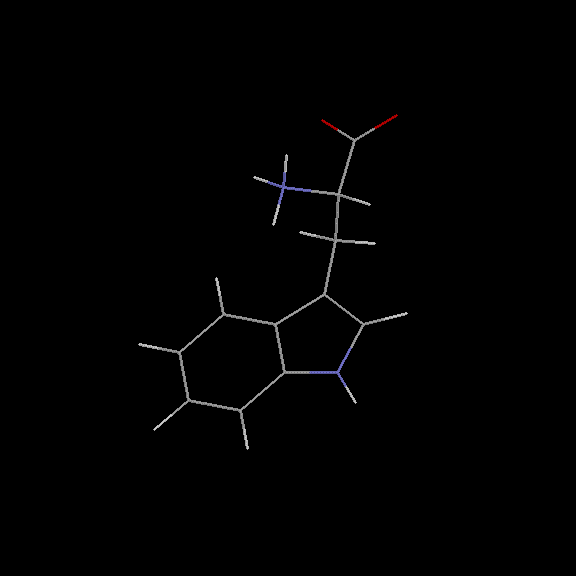L-tryptophan
Tryptophan, an α-amino acid, serves as a vital building block in the synthesis of proteins. It plays a crucial role in numerous biological processes, including serving as a precursor for various bioactive compounds and neurotransmitters such as serotonin and melatonin. Despite its relatively low abundance, it remains indispensable for the proper functioning of the human body.
Beyond its role in protein synthesis, tryptophan is intricately involved in diverse physiological functions, including the regulation of mood, sleep, and appetite. Moreover, it plays a key role in the maintenance of immune system health and the regulation of various metabolic pathways. Its multifaceted role in numerous biochemical processes has made it a subject of extensive research in the fields of nutrition, neuroscience, and medicine.
Researchers continue to explore the implications of tryptophan in the context of human health and disease, highlighting its potential therapeutic applications in various disorders related to mental health, sleep disorders, and immune system dysregulation. Its intricate relationship with several key metabolic pathways underscores the significance of tryptophan in the broader landscape of human biology and underscores its essential role in maintaining overall well-being.
Multifaceted Significance in Human Health and Disease
Tryptophan, an essential α-amino acid encoded by the UGG codon, plays a pivotal role in the synthesis of proteins, serving as a fundamental constituent in the process of protein formation. Its relative scarcity in the overall composition of vertebrate amino acids, comprising only 1.3% of total amino acids, emphasizes its critical nature despite its low abundance.
Aside from its foundational role in protein synthesis, tryptophan is intricately involved in a myriad of essential physiological functions, serving as a precursor for the biosynthesis of critical bioactive compounds and neurotransmitters, notably serotonin and melatonin. Its influence extends to the regulation of various biological processes, including mood, appetite, and sleep.
Tryptophan's contributions to the immune system are equally significant, as it plays a crucial role in supporting immune system function and overall immune response. Moreover, its role in modulating metabolic pathways underlines its importance in the broader context of human metabolism and overall physiological homeostasis.
Ongoing research continues to unveil the potential therapeutic implications of tryptophan in the context of mental health, sleep disorders, and immune system dysregulation. The multifaceted nature of tryptophan's influence underscores its indispensable role in maintaining overall human health and underscores its potential significance as a target for therapeutic interventions across a range of disorders.
Accession Number : KLM0000388 This work is released into the public domain; please see our release statement.
Doug Markham has contributed a molecular mechanics computation of the structure! See below for the details.

Synonyms :
- L-TRYPTOPHAN
- Trp
- W
Config Rule :
config('L-tryptophan',[
substituent(aminoacid_L_backbone),
substituent(indolyl),
linkage(from(aminoacid_L_backbone,car(1)),
to(indolyl,car(1)),
down,single)]).
%%%% Substituent Config Rules for compound 'L-tryptophan' %%%%
config(aminoacid_L_backbone,[
left(amino),
right(hyd),
top(carboxyl),
center(car(1))]).
config(indolyl,[
substituent('pyrrol-1-methandiyl-2,3-di-yl'),
substituent('benz-2,3-di-yl'),
conjugate('pyrrol-1-methandiyl-2,3-di-yl',pseudopos([car(2),car(3)]),'benz-2,3-di-yl',pseudopos([car(3),car(2)]))]).
%%%% Substituent Config Rules for compound indolyl %%%%
config('benz-2,3-di-yl',[
ring([
car(1,hyd)&,
car(2)&,
car(3)&,
car(4,hyd)&,
car(5,hyd)&,
car(6,hyd)&])]).
config('pyrrol-1-methandiyl-2,3-di-yl',[
substituent(methandiyl),
substituent('pyrrol-1,2,3-tri-yl'),
linkage(from(methandiyl,car(1)),
to('pyrrol-1,2,3-tri-yl',car(3)),
nil,single)]).
%%%% Substituent Config Rules for compound 'pyrrol-1-methandiyl-2,3-di-yl' %%%%
config('pyrrol-1,2,3-tri-yl',[
ring([
nit(1,hyd)&,
car(1)&,
car(2)&,
car(3)&,
car(4,hyd)&])]).
Smiles String :
[C@2H]([NH3+])([C](=[O])[O-])[C@2H2]-[c]1([c]2([c]([nH][cH]1)[cH][cH][cH][cH]2)_ ) 'L-tryptophan'
Terminal :
% 'L-tryptophan'
c(1,12,(0,chiral))-[n(1,left)~,h(1,right)~,c(2,up)~,c(3,down)~],
c(2,12,(0,nonchiral))-[o(1,nil)?,o(2,nil)?,c(1,down)~],
c(3,12,(0,nonchiral))-[c(6,left)~,h(5,right)~,c(1,up)~,h(6,down)~],
c(4,12,(0,nonchiral))-[c(5,flat)&,n(2,flat)&,c(12,flat)&],
c(5,12,(0,nonchiral))-[c(6,flat)&,c(4,flat)&,c(9,flat)&],
c(6,12,(0,nonchiral))-[c(3,right)~,c(7,flat)&,c(5,flat)&],
c(7,12,(0,nonchiral))-[h(8,nil)~,n(2,flat)&,c(6,flat)&],
c(8,12,(0,nonchiral))-[h(12,nil)~,c(13,flat)&,c(9,flat)&],
c(9,12,(0,nonchiral))-[h(9,nil)~,c(8,flat)&,c(5,flat)&],
c(12,12,(0,nonchiral))-[h(10,nil)~,c(4,flat)&,c(13,flat)&],
c(13,12,(0,nonchiral))-[h(11,nil)~,c(12,flat)&,c(8,flat)&],
h(1,1,(0,nonchiral))-[c(1,left)~],
h(2,1,(0,nonchiral))-[n(1,right)~],
h(3,1,(0,nonchiral))-[n(1,down)~],
h(4,1,(0,nonchiral))-[n(1,up)~],
h(5,1,(0,nonchiral))-[c(3,left)~],
h(6,1,(0,nonchiral))-[c(3,up)~],
h(7,1,(0,nonchiral))-[n(2,nil)~],
h(8,1,(0,nonchiral))-[c(7,nil)~],
h(9,1,(0,nonchiral))-[c(9,nil)~],
h(10,1,(0,nonchiral))-[c(12,nil)~],
h(11,1,(0,nonchiral))-[c(13,nil)~],
h(12,1,(0,nonchiral))-[c(8,nil)~],
n(1,14,(1,nonchiral))-[h(2,left)~,c(1,right)~,h(3,up)~,h(4,down)~],
n(2,14,(0,nonchiral))-[h(7,nil)~,c(7,flat)&,c(4,flat)&],
o(1,16,(-5.0E-01,nonchiral))-[c(2,nil)?],
o(2,16,(-5.0E-01,nonchiral))-[c(2,nil)?]
The Terminals for all the Config Rules are in Prolog Definite Clause Grammar (DCG) form.They can be checked in the Manual here.
The compound's PDB file can be seen here.
Doug Markham of the Institute for Cancer Research, Fox Chase Cancer Center,Philadelphia, PA, has contributed the following structure for L-tryptophan. He computed this structure in sdf format using MacroModel, a molecular mechanics program. We have used Babel to convert the .sdf format to PDB format. You'll find it interesting to compare these structures to those computed using CONCORD.
Many thanks Doug!
